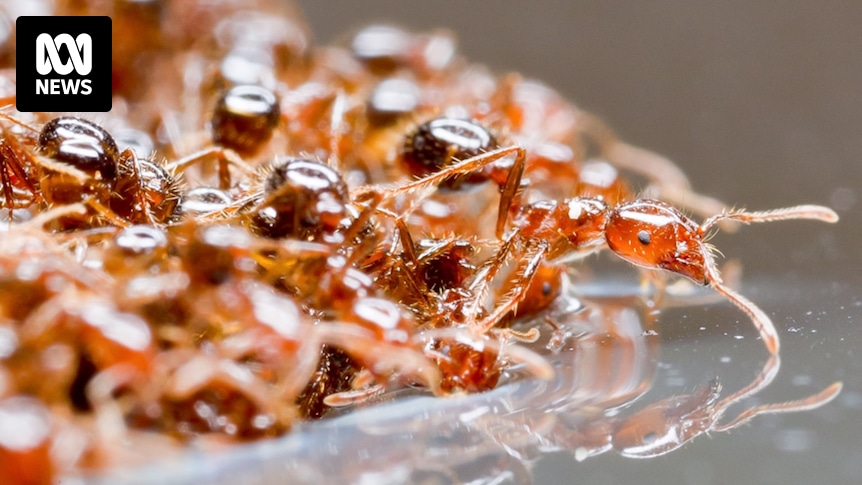
They swarm, they sting, and they might soon be in your backyard. Fire ants, notorious for their painful, burning sting, have been steadily advancing across southeast Queensland, Australia, spreading north, south, and west. This relentless march echoes a similar scenario in the United States, where the imported “super pest” has become more than just a nuisance. According to Mark Hoddle from the University of California’s Applied Biological Control Research Centre, fire ants are a daily hazard in the US.
“If the kids are out in the yard and they tread on one of these nests, the ants just boil out of it,” Professor Hoddle explained. “You’re not talking about one or two ants — there’s hundreds to thousands.”
As Australia fights to preserve its cherished outdoor lifestyle, the American experience serves as a stark warning of the potential costs of losing this war.
The War on Fire Ants
The National Fire Ant Eradication Program in Australia has received at least 463 reports of critical fire ant stings this year alone. In four instances, ambulances were called, and 20 cases required hospitalization. In contrast, the US sees an estimated 14 million people stung annually. Professor Hoddle, who has studied fire ants for three decades, describes the US battle against these pests as “the Vietnam of entomology,” a war that seems unwinnable with current technology.
“It’s ongoing and it will probably never be winnable with the technology we’re currently using,” he said. “It just seems like an intractable problem.”
Fire ants now infest more than 150 million hectares across 15 southern US states — an area larger than Australia’s Northern Territory. In Australia, a similar pattern is emerging, with rising opposition to chemical treatments deemed essential for controlling the pest.
Community Frustration and Resistance
On Queensland’s Scenic Rim, Kirsty McKenna has witnessed fire ant nests on her property grow from one to thousands. “I’m seeing us lose this fight, and I have been at least for the last five years,” she said. McKenna manages a fire ant Facebook group where members express frustration over what many perceive as a failing system.
“People are disheartened — we feel like we’re on our own battling this issue,” she lamented. “People are saying they’re no longer bothering to report, which worries me.”
Fire ant queens can fly up to five kilometers and lay about 2,000 eggs a day. When a nest is disturbed, a pheromone is released, causing the ants to swarm and sting repeatedly. Virginia Tech assistant professor of entomology Scotty Yang has studied fire ants in various countries, including Australia.
“When you get stung, you know how bad those fire ants are,” he said. “Repeated multiple stings can cause severe allergic reactions, which can be fatal for those with underlying conditions.”
Strategies and Challenges
Fire ants were first detected in Brisbane in 2001 but have spread rapidly across southeast Queensland in recent years. They now infest around 850,000 hectares and have crossed into New South Wales. A $592 million eradication program aims to directly exterminate nests in southeast Queensland. However, within this area lies a suppression zone where landholders must manage nests themselves.
The strategy involves treating the outer infested area and pushing inward, but it has faced criticism from residents who fear unchecked populations in the suppression zone could undermine the entire program.
Inside the suppression zone, turf farmer John Keleher has spent $1.5 million over the past two years managing fire ants on his property. “It’s two to three hours of my day every day just complying with the necessary paperwork and treatment regime,” he said. Yet, his neighbors on rural residential blocks are not subject to the same stringent requirements, relying instead on self-reporting.
“I’m directly looking into a neighbor’s property and the pest population of ants there is endemic,” Keleher said. “They’re mating, they’re flying onto my land, and I’m having to deal with the problem.”
Looking Ahead
Despite legal requirements for landholders to allow biosecurity officers onto their properties, resistance has been encountered, fueled in part by misinformation. The National Fire Ant Eradication Program’s general manager of operations, Marni Manning, noted that efforts inside the suppression zone are being expanded, including aerial baiting.
“The more we weaken the population in the suppression area, the better eradication effectiveness will be,” she said.
The program uses corn grit baits soaked in soybean oil containing insect growth regulators approved by the Australian Pesticides and Veterinary Medicines Authority. These chemicals prevent fire ant queens from producing mature worker ants, effectively killing a colony over time. However, concerns about environmental impact remain, particularly with baiting from helicopters.
Invasive Species Council advocacy manager Reece Pianta emphasized the environmental friendliness of this approach. “Native ants will forage this product and take it away, but the product is designed so the oil component of it is far more attractive to fire ants,” he said.
With the clock ticking, Australia faces a critical juncture in its battle against fire ants. Beyond the medical, environmental, and economic costs, the risk to outdoor lifestyles looms large. Professor Hoddle warns that Australia has a narrow window to act, but it may already be too late.
“With a lot of these programs, it often reaches a critical area of infestation where containment may or may not be possible,” he said. “Eradication now is almost certainly off the table because the area that’s infested, it’s just too big to manage.”
Yet, there remains hope. Dr. Yang believes eradication is possible if governments, landholders, and everyday Australians act swiftly. “Australia is the last one standing, still fighting fire ants with the goal of eradication,” he said. “It’s a big shock to me — I thought Australia had a really good chance to eradicate.”
With Queensland committing an additional $24 million over two years to bolster suppression efforts, the fight continues. “These super pests stand to inhabit at least 97 percent of this country,” Manning warned. “We’re not giving up on eradication.”







